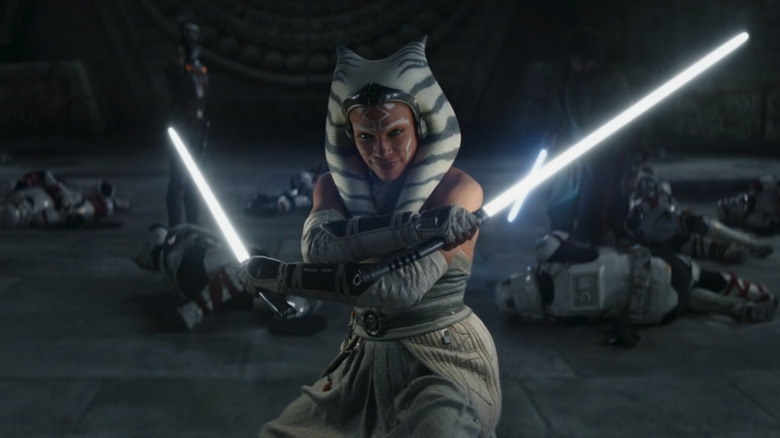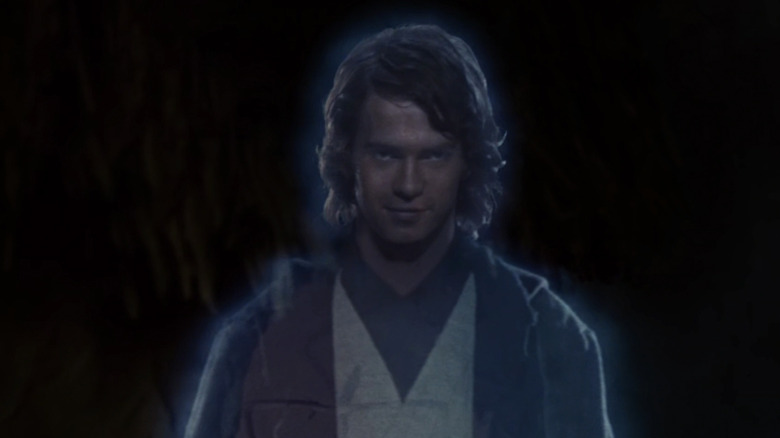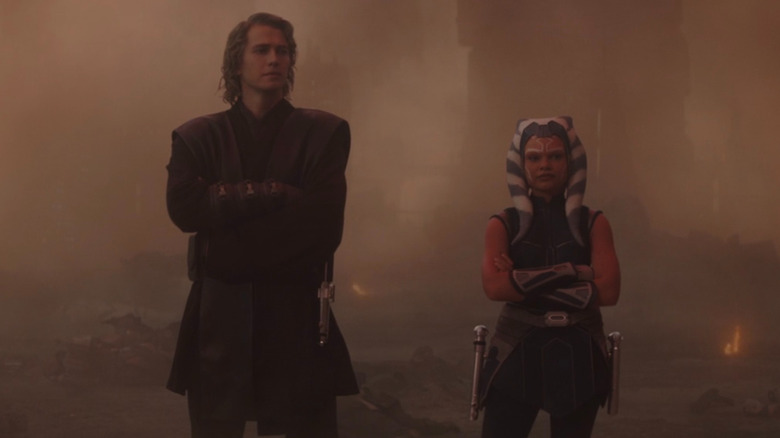Ahsoka Made George Lucas's Most Controversial Star Wars Change Pay Off
This article contains spoilers for the "Ahsoka" season 1 finale, "The Jedi, the Witch, and the Warlord."
George Lucas has been making changes to the original theatrical releases of the "Star Wars" movies since day one. "A famous filmmaker once said that films are never completed, they are only abandoned," Lucas said in an interview from a January 1997 issue of Starlog. "So rather than live with my 'abandoned' movies, I decided to go back and complete them."
For the original "Star Wars," before it was given the title of "A New Hope," there really is no original theatrical edition, as it was a different film depending on how you saw it. If you caught it in mono as opposed to stereo, there were different quirks to the dialogue (and even some actors). For "The Empire Strikes Back", the ending shots of the Rebellion's fleet were added weeks after the initial release.
No one seemed to notice these more minor modifications, but in 1997, George Lucas released the "Star Wars Trilogy: Special Edition." There were definitely some decisions that made the new versions of the films unquestionably better, but other changes made some fans scratch their heads and others launched debates that still won't die. For instance, Greedo firing his gun in that famous standoff with Han Solo.
But every time there came an opportunity to revisit and realign the films with his original vision, George Lucas kept making alterations. Jabba the Hutt's appearance in "A New Hope" has gotten better with each iteration as technology has gotten better. Han went from firing first, to firing second, to firing at Greedo at the same time after Greedo says "Maclunkey."
For the 2004 DVD release of the original "Star Wars" trilogy, George Lucas made a change that is, in some circles, highly controversial. But now, thanks to "Ahsoka," it might hit a little bit differently.
Anakin Skywalker's Force ghost
At the end of "Return of the Jedi," Luke Skywalker turns his back on the Ewok's victory celebration and looks on as the Force ghosts of Yoda, Obi-Wan Kenobi, and his father, Anakin Skywalker appear. Originally, Anakin was played by veteran actor Sebastian Shaw. He appeared in the scene where Vader's mask is first taken off and appears here at the end on the forest moon of Endor in full Jedi robes alongside his former masters.
But in 2004, a full year before the release of the final installment of the prequel trilogy, George Lucas removed Sebastian Shaw from this moment in the film and replaced him with Hayden Christensen, who played Anakin in "Attack of the Clones" and "Revenge of the Sith."
For some, this was a bridge too far, and they swore off "Star Wars," for at least a little while. They felt that it somehow betrayed Sebastian Shaw or the integrity of "Star Wars. Though they thought it made enough sense that Shaw's version of Anakin could appear in Jedi robes, him appearing as a younger version of himself, the last time he was truly good and likely the way he thought of himself, made no sense.
For fans of the prequels and "Star Wars" in general, this moment enhanced the cohesiveness of both trilogies. And for people who loved the conflict and character of Anakin Skywalker, it provided a much more emotional moment for him at the end.
The Clone Wars
One thing George Lucas and Dave Filoni did for Anakin Skywalker that movies might have only hinted at was to flesh out his character and make him far more sympathetic. Part of that was in giving Anakin a Padawan in the form of Ahsoka Tano. Together, they formed a bond like one we would have hoped Anakin could have formed with his children, had he not turned to the dark side.
Ahsoka became an incredible character in her own right, stepping out from the shadows of Anakin and becoming her own person, though, as we saw in earlier episodes of "Ahsoka," she still felt the darkness of that shadow inside her. She hoped for the best for her former master and was shocked to discover that he had become Darth Vader.
It's unknown if she's aware that he had turned to back to the light at the end, though it seems likely, since she did connect with Luke Skywalker. But she's never had a reunion with him since that point.
Anakin's ghostly pride
At the end of the first season of "Ahsoka", there could be no more powerful image than that of Ahsoka's former master looking over her and watching out for her. Since Hayden Christensen was already back on board for the show, playing the character in Force vision flashbacks, it made perfect sense to bring him back for this one, beautiful moment.
Had George Lucas not made the change in "Return of the Jedi," this moment would have been confusing and had very little impact. But because George Lucas had the forethought to make the change in the first place, future generations of "Star Wars" viewers, who won't know or care about the previous versions of the movies beyond what is streaming on Disney+, will see a unified connection between the various eras of "Star Wars," including those emotional anchors that make the shows something truly special.
To see his little smile there at the end, as the last shot of the show, giving his quiet approval and pride to his former Padawan, felt like a moment of catharsis and the perfect way to end the season.
All eight episodes of the first season of "Ahsoka" are available to stream on Disney+.



